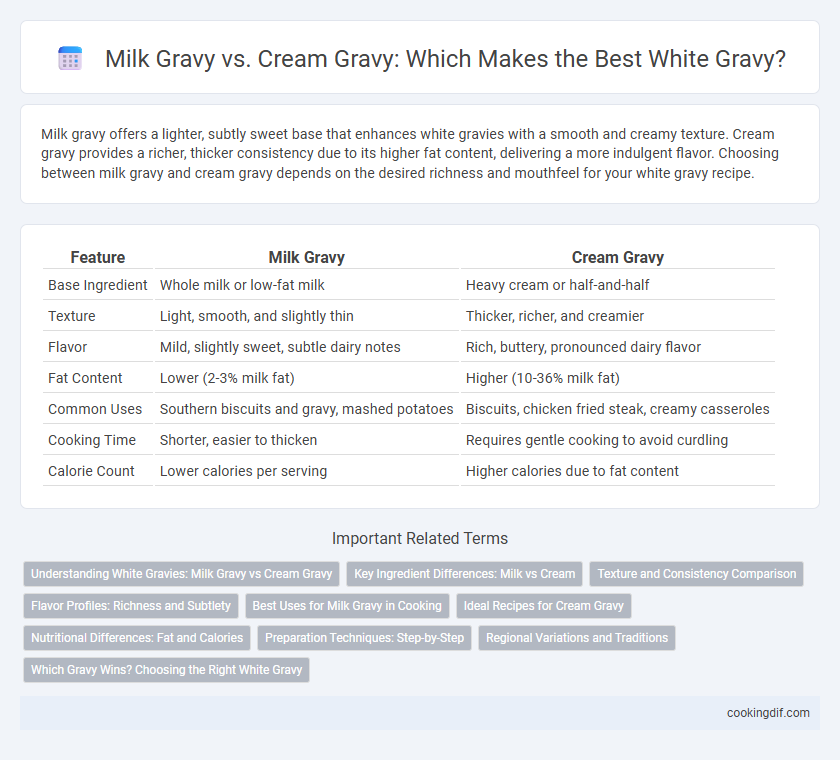Milk gravy offers a lighter, subtly sweet base that enhances white gravies with a smooth and creamy texture. Cream gravy provides a richer, thicker consistency due to its higher fat content, delivering a more indulgent flavor. Choosing between milk gravy and cream gravy depends on the desired richness and mouthfeel for your white gravy recipe.
Table of Comparison
| Feature | Milk Gravy | Cream Gravy |
|---|---|---|
| Base Ingredient | Whole milk or low-fat milk | Heavy cream or half-and-half |
| Texture | Light, smooth, and slightly thin | Thicker, richer, and creamier |
| Flavor | Mild, slightly sweet, subtle dairy notes | Rich, buttery, pronounced dairy flavor |
| Fat Content | Lower (2-3% milk fat) | Higher (10-36% milk fat) |
| Common Uses | Southern biscuits and gravy, mashed potatoes | Biscuits, chicken fried steak, creamy casseroles |
| Cooking Time | Shorter, easier to thicken | Requires gentle cooking to avoid curdling |
| Calorie Count | Lower calories per serving | Higher calories due to fat content |
Understanding White Gravies: Milk Gravy vs Cream Gravy
Milk gravy, also known as white gravy, uses milk as a base, creating a lighter, thinner consistency with a subtle dairy flavor ideal for classic Southern dishes like biscuits and gravy. Cream gravy incorporates heavy cream or half-and-half, resulting in a richer, thicker texture and a more decadent taste, perfect for indulgent comfort foods. Both rely on a roux made from fat and flour, but the choice between milk and cream affects the gravy's creaminess, mouthfeel, and flavor intensity.
Key Ingredient Differences: Milk vs Cream
Milk gravy uses regular milk as its base, providing a lighter texture and a milder flavor profile ideal for everyday comfort dishes. Cream gravy, on the other hand, incorporates heavy cream, resulting in a richer, thicker consistency and a more indulgent taste often preferred for special meals. The essential difference lies in fat content, with cream gravy containing higher fat levels that enhance the gravy's smoothness and depth.
Texture and Consistency Comparison
Milk gravy features a lighter, thinner texture with a smooth consistency, making it ideal for dishes requiring a delicate white gravy. Cream gravy offers a richer, thicker consistency due to higher fat content, creating a velvety mouthfeel that clings well to biscuits or meats. The choice between milk and cream gravy depends on desired creaminess and the gravy's ability to coat and complement the dish.
Flavor Profiles: Richness and Subtlety
Milk gravy offers a lighter, subtly creamy flavor profile with a delicate sweetness that enhances dishes without overpowering them. Cream gravy delivers a richer, more indulgent taste due to its higher fat content, creating a velvety texture and deeper mouthfeel. Both gravies complement white sauces, with milk gravy suited for subtle flavor enhancement and cream gravy ideal for bold, luxurious richness.
Best Uses for Milk Gravy in Cooking
Milk gravy's lighter texture and subtle flavor make it ideal for dishes like biscuits and mashed potatoes where a creamy, delicate sauce enhances rather than overpowers. Its lower fat content compared to cream gravy pairs well with poultry, pork, and vegetables, providing a smooth, comforting complement without heaviness. Milk gravy also serves as a versatile base for adding herbs and spices, allowing cooks to customize flavors for casseroles, breakfast dishes, and southern-style comfort foods.
Ideal Recipes for Cream Gravy
Cream gravy, known for its rich texture, shines in classic Southern dishes like chicken-fried steak and biscuits, where its smoothness complements fried or roasted meats perfectly. Unlike milk gravy, cream gravy uses heavy cream or half-and-half, providing a thicker consistency and a more flavorful, silky finish. Ideal recipes emphasize slow simmering to meld the cream with pan drippings and seasoned flour, creating a luscious, velvety sauce that enhances savory comfort foods.
Nutritional Differences: Fat and Calories
Milk gravy typically contains lower fat and fewer calories compared to cream gravy, making it a lighter option for white gravies. Cream gravy is richer due to the higher fat content from heavy cream, which significantly increases its calorie density. Choosing milk gravy can support lower calorie intake while still providing a creamy texture in traditional southern dishes.
Preparation Techniques: Step-by-Step
Milk gravy begins with a simple roux made by whisking equal parts butter and flour until golden, then gradually adding warm milk while stirring constantly to avoid lumps, creating a smooth, creamy base. Cream gravy follows a similar roux technique but uses heavy cream or half-and-half instead of milk, resulting in a thicker texture and richer flavor, often requiring slightly longer simmering to achieve the desired consistency. Both gravies benefit from seasoning with salt, pepper, and optional herbs, but milk gravy suits lighter dishes while cream gravy complements heartier meals.
Regional Variations and Traditions
Milk gravy, common in Southern United States cooking, offers a lighter, subtly sweet base cherished in traditional breakfast dishes such as biscuits and gravy. Cream gravy, often found in Midwestern and Southern Creole cuisine, uses heavy cream for a richer, thicker texture and a more decadent flavor profile. Regional variations reflect cultural preferences, with milk gravy favoring everyday comfort and cream gravy reserved for special occasions or richer meal pairings.
Which Gravy Wins? Choosing the Right White Gravy
Milk gravy offers a lighter texture and subtle flavor ideal for everyday dishes, while cream gravy provides a richer, thicker consistency favored in Southern cooking. The choice between milk gravy and cream gravy depends on the desired richness and dish application, with cream gravy winning when a bold, velvety finish is needed. Prioritize milk gravy for delicate pairings and cream gravy when a hearty, indulgent white gravy is preferred.
Milk Gravy vs Cream Gravy for white gravies Infographic

 cookingdif.com
cookingdif.com